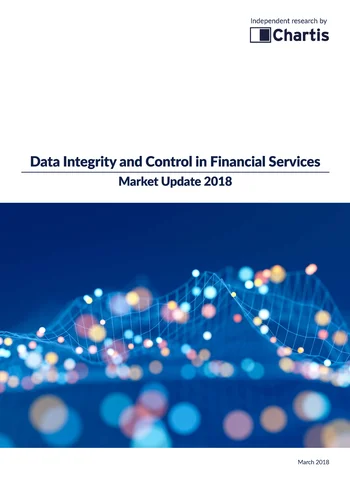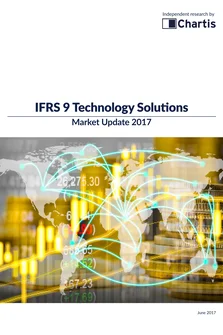This report updates Data Integrity and Control Solutions in Financial Services 2016. It examines how the dynamics in this space have shifted since that report was published, and the implications for Financial Institutions (FIs) and technology vendors. This report provides key updates, and outlines our developing thesis – for our original thesis and analysis please refer to the 2016 report.

FIs need data, to keep regulators and customers happy and profit margins healthy. Data needs to be in good shape so FIs, their clients, and their employees, can manage and manipulate it effectively. And even after FIs have their data’s 3Vs – volume, variety and velocity – under control, privacy and integration will emerge as the big stumbling blocks to getting value out of it.
The past year has seen explosive growth in the creation and use of unstructured data, much of which has, by necessity, begun to evolve into a more structured form. For FIs, parsing unstructured data for investment decisions, for example, can consume vast amounts of IT infrastructure and cloud elasticity, and involve considerable manual intervention from staff. This trend applies to risk management too. While risk systems take advantage of ever more unstructured data to generate deeper insights to support decision-making, manual intervention, reconciliation, matching and statistical techniques are required to provide much-needed structure.
The problem is that FIs’ fundamental data operations are simply not good enough. Pressured profit margins mean that focusing on Data Integrity and Control (DI&C) solutions is now essential for FIs, and will become a significant competitive differentiator in future. Paradoxically, however, the same profit pressures mean that DI&C is being pushed down FIs’ list of priorities.
As the DI&C environment continues to evolve rapidly in the next few years, the gap between bad practice, average practice and good practice among FIs will become clearer. Those exhibiting best practice will exhibit ‘full’ DI&C – adopting a holistic approach to the discipline, with strong management and data governance processes, and a contemporary data content engineering and IT platform. In addition, ontology tools have emerged as a central feature of successful DI&C: to be used effectively in many applications, data must have consistent meaning.
FIs must also invest in the latest, most effective technologies for automation – specifically Artificial Intelligence (AI) and Machine Learning (ML). In the most successful FIs, automation will increase substantially, replacing cumbersome, recurring and often hidden manual processes. Eventually, Distributed Ledger Technologies like blockchain may even remove the need for reconciliation, one of FIs’ biggest technology-related operational costs.
Very few FIs are operating at this level of DI&C today, however. So far only the largest organizations are exhibiting best practice, although even they are yet to achieve it consistently throughout their operations. Hardly surprising then that a fragmented solutions market, in which FIs stitch together a patchwork quilt of third-party, internally developed and external services to create workable solutions, has grown up around them.

This fragmentation is reflected in the supply side of the market. While some vendors largely adopt a ‘mix and match’ approach to their solutions, others focus on a specific aspect of the DI&C cycle, be it lineage, governance or reconciliation. An important factor in this is the size of the vendor: a typical large DI&C vendor, for example, will tend not to specialize in a single DI&C category. For smaller and newer vendors, meanwhile, the DI&C environment is likely to get tougher – building use cases around data takes time and money.
Nevertheless, vendors have started to merge their DI&C criteria and go after opportunities in a common solutions space, albeit at different speeds. The result is that many vendors rely on the varied and fragmented nature of the market – and FIs’ patchwork approach – to provide full solutions. But both groups will have to start thinking more holistically if they are to tap the growing opportunity this evolving market will offer.
This report uses Chartis’ FinTech Quadrant™ – as part of its supply-side analysis – to explain the structure of the DI&C market. The FinTech Quadrant™ uses a comprehensive methodology that involves in-depth independent research and a clear scoring system to explain which technology solutions meet an organization’s needs. The FinTech Quadrant™ does not simply describe one technology option as the best DI&C solution; rather it has a sophisticated ranking methodology to explain which solutions are best for specific buyers, depending on their implementation strategies.
This report covers the leading vendors offering DI&C solutions, including Asset Control, AxiomSL, Broadridge, Duco, FIS, Fiserv, GoldenSource, Gresham, IBM, Intellect Design, Irion, Oracle, Prometeia, Sapient, SmartStream, Wolters Kluwer, Workiva and zeb.
Only users who have a paid subscription or are part of a corporate subscription are able to print or copy content.
To access these options, along with all other subscription benefits, please contact info@chartis-research.com or view our subscription options here: https://www.chartis-research.com/static/become-a-member
You are currently unable to print this content. Please contact info@chartis-research.com to find out more.
You are currently unable to copy this content. Please contact info@chartis-research.com to find out more.
Copyright Infopro Digital Limited. All rights reserved.
As outlined in our terms and conditions, https://www.infopro-digital.com/terms-and-conditions/subscriptions/ (point 2.4), printing is limited to a single copy.
If you would like to purchase additional rights please email info@chartis-research.com
Copyright Infopro Digital Limited. All rights reserved.
You may share this content using our article tools. As outlined in our terms and conditions, https://www.infopro-digital.com/terms-and-conditions/subscriptions/ (clause 2.4), an Authorised User may only make one copy of the materials for their own personal use. You must also comply with the restrictions in clause 2.5.
If you would like to purchase additional rights please email info@chartis-research.com



